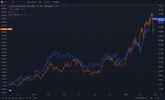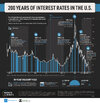over9k
So I didn't tell my wife, but I...
- Joined
- 12 June 2020
- Posts
- 5,398
- Reactions
- 7,772
we are already in a hyperinflationary cycle. Inflation is actually very easily correlated to M2 Money supply. The M2 has increased from 15trillion just precovid to almost 22 trillion today. thats around 40% increase over 2 years(20%/year). Inflationary effects flow through in 1.5 to 2 years later, so we can expect inflation to be super high next couple years at least to 2024 if there are no major steps taken to stop M2 money creation. Last year US budget deficit ran around 2.8trillion so we are likely to see another 3 or 4 trillion printed this election year, which means no end to inflation till at least 2025 if rates dont go to at least probably 20% like during the Volcker years in the 80s and a major reset/recession is triggered.yep , transitory to runaway or hyper-inflation , how can i tell the Fed is starting to move nearly 8% behind official CPI rises and probably 12% to 15% behind REAL inflation give me 12% start over one mile and i still might beat most my age ( heart disease and all )
and those fuel prices they are a COMPOUNDING factor ( a bit like GST ) every time the produce moves the cost goes UP ( the same bit of merch. ) if it was 10% once per item folks could adjust in a while
No, incorrect:we are already in a hyperinflationary cycle. Inflation is actually very easily correlated to M2 Money supply. The M2 has increased from 15trillion just precovid to almost 22 trillion today. thats around 40% increase over 2 years(20%/year). Inflationary effects flow through in 1.5 to 2 years later, so we can expect inflation to be super high next couple years at least to 2024 if there are no major steps taken to stop M2 money creation. Last year US budget deficit ran around 2.8trillion so we are likely to see another 3 or 4 trillion printed this election year, which means no end to inflation till at least 2025 if rates dont go to at least probably 20% like during the Volcker years in the 80s and a major reset/recession is triggered.


I am sure there are plenty of members of the ASF who remember the GFC , and what triggered that rather messy event.The Federal Reserve (the Fed) is the central bank of the United States. It sets monetary policy, including control of the benchmark short-term interest rate known as the Federal Funds rate, or in Wall Street jargon, the “Fed Funds” rate. This is a key rate because it signals the rate at which overnight loans are made between financial institutions and the direction of interest rates in general.
Unfortunately, over time, the Fed has also been granted a supervisory role by Congress over Wall Street’s megabanks alongside its ability to bail them out when its crony brand of supervision fails. There was an epic failure in the Fed’s supervision of the Wall Street megabanks in the leadup to the 2008 financial crash and the September 2019 repo blowup. In both cases, the Fed made trillions of dollars in cumulative loans at below-market interest rates to the trading units of these megabanks in order to resuscitate them and cover up its own failure to properly supervise the banks.
Its just a matter of time before the next Bear Stearns event pops up.The convulsions the stock market experienced last Thursday and Friday, that investors will continue to witness in the days ahead, are inextricably tied to the failure of Congress to strip the Fed of a supervisory role over these global megabanks.
There is no better snapshot of the Fed’s failure as a banking supervisor than this one fact that is called out every quarter in the Office of the Comptroller of the Currency’s Report on Bank Trading and Derivative Activities. Table 14 of this report (see page 19) shows that the 25 largest bank holding companies in the U.S. are sitting on $234 trillion notional (face amount) in derivatives but just five bank holding companies are responsible for $200.18 trillion of that exposure or 86 percent of the total. Those mega bank holding companies are: JPMorgan Chase (ticker JPM), Citigroup (C), Goldman Sachs (GS), Morgan Stanley (MS) and Bank of America (BAC).
The table also clearly shows that the most dangerous form of these derivatives – the same credit derivatives that blew up Wall Street in 2008 – are also concentrated at those same five bank holding companies.
I am aware that some embers of the ASF are putting their faith in the miracle working powers of Saint Jerome, however, I just cannot join the worshippers.
From Wall street on parade
I am sure there are plenty of members of the ASF who remember the GFC , and what triggered that rather messy event.
It seems that some entities just never learn.
Its just a matter of time before the next Bear Stearns event pops up.
Watch the carnage then.
Mick

Note that i disagree on some points but this is an argumented position and you might be right.I agree with the criticism of the Fed but there is no other alternative. We don't live in a reality where there is a perfect central bank that can prevent all financial disasters - and to be honest I don't think one ever could.
The St Jerome parable is mostly facetious, but there is some truth to it. Recall the miracle of March 2020. Mass unemployment and economies staring down the barrel of multiple companies imposing due to list income/business activities. And then from nowhere, St Jerome heralds in a $6 trillion godsend that averts global financial armageddon.
These sort of plays are characteristic of governments and central banks. When traders think they have everything figured out (particularly during corrections) and that the market should decline in some orderly, predictable and expected manner, some surprise policy, tool or facility gets introduced and whatever/whoever "should have happened" gets annihilated.
More importantly, these plays are welcome and arguably necessary to save markets from themselves. Why should the wider economy (and society) suffer because of insane volatility or extended declines in what is essentially an abstract, electronic gambler's den (i.e the markets)?
The debate RE: interest rates is the perfect example of this. Calls for interest rates to start increasing to what they were in the 80s make no sense and are a knee-jerk, disastrous solution to a problem (inflation) that is still evolving, particularly when viewed in the historical context (declining interest rates being the norm).
View attachment 140919
The interest rate arguments are in some respects, just a sideline to the real issue that was outlined, namely the way the FED supplied huge amounts of money to the leading commercial banks, and the way they used it to create further truck loads of artificial financial products that serve to do only one thing- namely to enrichen the banks.I agree with the criticism of the Fed but there is no other alternative. We don't live in a reality where there is a perfect central bank that can prevent all financial disasters - and to be honest I don't think one ever could.
The St Jerome parable is mostly facetious, but there is some truth to it. Recall the miracle of March 2020. Mass unemployment and economies staring down the barrel of multiple companies imposing due to list income/business activities. And then from nowhere, St Jerome heralds in a $6 trillion godsend that averts global financial armageddon.
These sort of plays are characteristic of governments and central banks. When traders think they have everything figured out (particularly during corrections) and that the market should decline in some orderly, predictable and expected manner, some surprise policy, tool or facility gets introduced and whatever/whoever "should have happened" gets annihilated.
More importantly, these plays are welcome and arguably necessary to save markets from themselves. Why should the wider economy (and society) suffer because of insane volatility or extended declines in what is essentially an abstract, electronic gambler's den (i.e the markets)?
The debate RE: interest rates is the perfect example of this. Calls for interest rates to start increasing to what they were in the 80s make no sense and are a knee-jerk, disastrous solution to a problem (inflation) that is still evolving, particularly when viewed in the historical context (declining interest rates being the norm).
View attachment 140919
Walmart drivers can now earn $110,000 in their first year.
The national average is $56,491.
Guess it will just be a matter of time before OZ truckers start to emmigrate to the US.tell me how this isn't a product of unusual times. Shortage of truck drivers in USA:

Drive-In Opportunity: Walmart Raises Driver Pay and Launches Private Fleet Development Program
Throughout Walmart’s history, we’ve been committed to turning ambition into opportunity. In the last several years, we’ve cast a wide net, inviting associates from across the business to learn more, see more and do more.Now, we’re taking that same approach to the very foundation of our supply...corporate.walmart.com
actually more supply disruptions elsewhere have been pivotal ( Iraq , Syria , Libya , Yemen , Nigeria , policy decisions in the US and Canada ) Russia could have stopped exporting without almost being noticed , if those other issues hadn't front-run the current situationProblem is, so much of it is supply side driven with the sanctions on russian oil. To be fair to the fed, that's well & truly beyond their control.
A supply side inflation spike means stagflation, this is a fact.
Russia's almost 20% of global oil exports. IIRC, this last year, saudi arabia pumped its highest amount of oil in history.actually more supply disruptions elsewhere have been pivotal ( Iraq , Syria , Libya , Yemen , Nigeria , policy decisions in the US and Canada ) Russia could have stopped exporting without almost being noticed , if those other issues hadn't front-run the current situation
and China jamming up it's ports added to the problem as well
i don't think so , but it is going to be interesting to watch the EU put the final nail in it's own coffinIt's the cutoff of russian oil guys, not the fed, jesus christ...
and some estimates are the Saudis are pumping the maximum ( sensible ) amount they can ( give or take the odd Yemeni rocket/drone )Russia's almost 20% of global oil exports. IIRC, this last year, saudi arabia pumped its highest amount of oil in history.
Russia could have stopped exporting without almost being noticed
The inflationary pressures were there long before the Ukraine Invasion started.It's the cutoff of russian oil guys, not the fed, jesus christ...
to EUROPE is the key , there are ( much more ) expensive optionsHuh? How could a country that accounted for about 45% of the EU's gas imports and 40% of its entire gas consumption stop exporting gas without being noticed?
Hello and welcome to Aussie Stock Forums!
To gain full access you must register. Registration is free and takes only a few seconds to complete.
Already a member? Log in here.